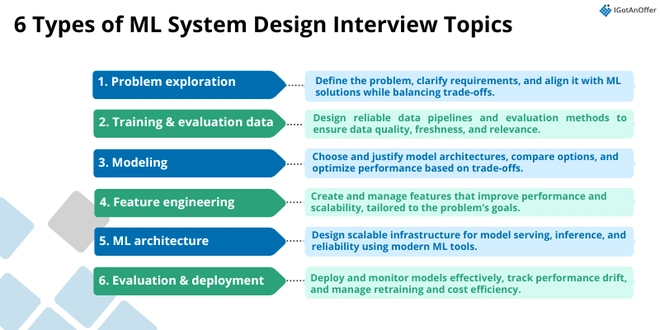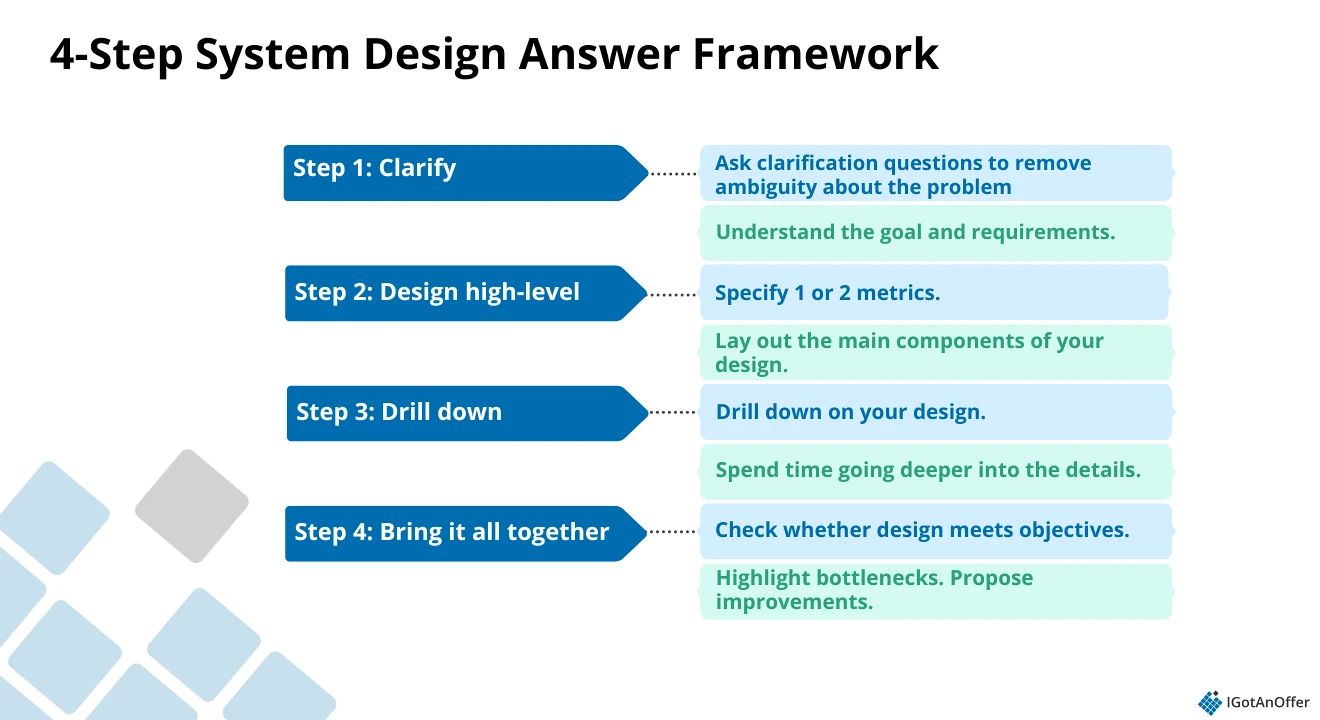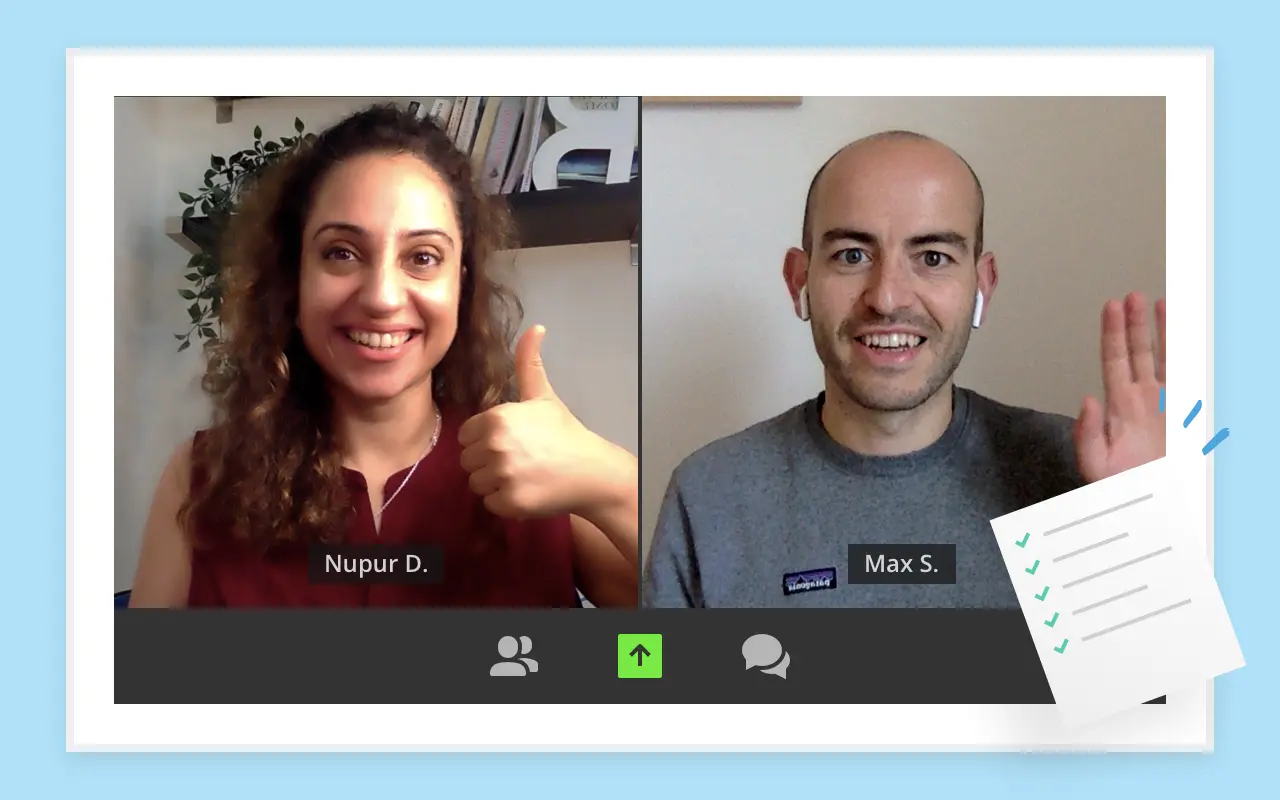The demand for ML-focused roles is growing, and to qualify, you’ll need to show that you can build useful, working ML systems that solve real-world problems. If you’re targeting a mid- to senior-level AI and ML role, expect ML system design interviews as a core part of your interview process.
To succeed in these interviews, you’ll need strong ML breadth, a solid understanding of system design principles, and the ability to balance trade-offs between accuracy, latency, cost, and user experience while clearly explaining your reasoning.
Below, you’ll find real ML system design interview questions from Google, Meta, and Amazon, along with a sample answer outline by an expert and a framework.
Finally, we’ll share the best resources, expert tips, and a step-by-step prep plan to help you walk into your ML system design interview with confidence.
Here’s an overview of what we’ll cover:
- What to expect from your ML system design interview
- Different topics covered in ML system design interviews
- Example ML system design interview question (+ answer)
- More ML system design question examples
- How to prepare for ML system design interviews
Click here to practice 1-on-1 with ML ex-interviewers
Let’s get started!
1. What to expect from your machine learning (ML) system design interview↑
Machine learning system design questions can come up in various roles. They are often asked in interviews for applied scientist, ML-focused data scientist, research scientist, applied science manager, and software development manager positions.
In this article, though, we’ll focus on ML system design for AI/ML engineering roles.
Below, you’ll find some commonly asked questions so you know what to expect in your interview.
1.1 What is an ML system design interview?
An ML system design interview assesses your ability to design and implement a production-ready machine learning system from end to end. These interviews are typically 35-60 minutes long and may appear in the onsite stage after passing the initial phone screen.
ML system design questions typically begin with an open-ended prompt, such as “Design a product recommendation system” or “Design autocomplete on a mobile device.”
From there, you’ll be expected to outline a high-level design that covers data pipelines, model training, serving, and monitoring. You’ll also need to explain how these components connect and the trade-offs you’re making.
The goal of ML system design questions is to test whether you can design scalable, reliable systems that deliver real business value. You’ll need to build a technically sound solution while weighing factors such as cost, latency, interpretability, user experience, and more.
In “standard” system design interviews, you focus mainly on designing distributed systems and managing infrastructure components. Both follow similar principles, but ML system design goes a step further by integrating data pipelines, model training, and serving into the overall system.
1.2 What skills are assessed in ML system design interviews?
According to Oussama (ex-Amazon ML Solutions Architect), you’ll be typically tested on:
- Your ability to connect ML models with scalable production systems
- Understanding of trade-offs between accuracy, latency, cost, interpretability, and user experience
- Knowledge of the ML breadth/lifecycle, including data collection, feature pipelines, model training, deployment, and monitoring
- Ability to communicate clearly by asking the right questions and stating assumptions
- Ability to apply structured thinking and prioritization when making design choices
1.3 “Standard” system design vs ML system design vs AI system design interviews
Not to confuse the three, ML system design interviews are slightly different from the “standard” system design questions you’ll encounter in roles like software engineering, and from the newer AI system design interviews now being asked in senior or AI-focused roles.
Here’s how they differ:
Standard system design
System design interviews test your ability to design distributed systems that can operate at a massive scale. You’ll be expected to address topics such as availability, scalability, partition tolerance, reliability, storage, and databases.
ML system design
ML system design interviews are similar to standard system design questions in that you’ll need to outline a high-level approach for a system or problem. You’ll still be expected to cover concepts such as databases, microservices, APIs, queues, and functional or non-functional requirements.
The main difference is that you’ll need to design a machine learning solution in ML system design interviews and explain the full pipeline (data collection, preprocessing, model arch, loss function, optimization, serving, and monitoring).
You’ll also be expected to “identify the right model for the problem, weigh trade-offs between models, and define the data and feature sets the model should use,” says Ashish (ex-software engineer, AI/ML-focused).
AI system design
Lastly, AI system design interviews often focus on how to apply large language models (LLMs) to real business problems.
Oussama says you can expect these types of questions in Principal, Staff, or Senior engineering roles if the company is hiring for AI system adoption.
He adds that in these interviews, you might encounter problems that ask you to design an ‘agentic system’, where the model acts as an “agent” that can reason and take actions (e.g., calling APIs, scheduling meetings, or placing orders).
Another common AI system design challenge is to design a ‘wrapper application’, where the LLM is embedded into a traditional software product with a custom interface or workflow (e.g., adding an AI writing assistant into a document editor, or integrating an LLM into a customer support tool).
AI system design differs from ML system design in that the focus is less on building the ML pipeline and more on designing AI-first software. Hence, Oussama says you might not be expected to go as deep into ML architecture or breadth.
1.4 Which roles are most likely to face ML system design questions during interviews?
According to Tejash (Amazon software development manager, ML focus), machine learning system design questions are frequently asked in mid- to senior-level engineering positions. The exact roles and titles vary by company, but here are some of the most common job titles:
- Machine learning engineer (MLE) – typically responsible for building and scaling ML models in production.
- Applied AI engineer – product-focused engineers working on teams that embed AI into features (e.g., feed, search, ads relevance).
- AI infrastructure / platform engineer – engineers focused on the lifecycle infrastructure for ML systems (e.g., model training, serving, feature stores, inference optimization).
- Engineering manager (ML focus) – includes Amazon’s software development managers (SDMs) and equivalent titles at other companies, leading ML-heavy teams or AI-first initiatives.
2. 6 Different topics covered in ML system design interviews↑
The topics covered in ML system design interviews can be broad and varied. Based on insights from coaches Ashish (ex-software engineer, AI/ML-focused), Oussama (ex-Amazon ML Solutions Architect), Yahia (Spotify ML engineering manager), and Tejash (Amazon SDM, ML focus), we’ve narrowed down the areas you should focus on during your preparation.

2.1 Problem exploration
These questions focus on how you explore the problem, define and develop the product requirements, and evaluate different ML solutions to a problem. Interviewers want to see if you can translate vague goals into clear system requirements while balancing trade-offs.
- Defining the business problem and aligning it with ML solutions
- Balancing trade-offs between accuracy, latency, interpretability, cost, and user experience
- Identifying common ML system patterns (ranking, ads, recommendations)
- Clarifying requirements: functional and non-functional (e.g., latency, scale, multilingual, multimodal support)
Example question: “How would you design a personalized news ranking system?”
2.2 Train / evaluation data strategy
A well-designed ML system depends on the quality of its data. With this topic, interviewers will assess how you approach collecting, processing, and managing training and evaluation data in a production setting. They’ll want to see if you can design effective strategies for ensuring data reliability, freshness, and relevance throughout the ML lifecycle.
- Data pipelines (batch vs. streaming)
- Handling ever-changing / incoming data
- Experimentation design (A/B testing, online experimentation pitfalls)
- Evaluation strategies for models and systems
- Feature selection and transformation (handling imbalanced datasets, artificial features if needed)
Example question: “How would you set up an A/B test to evaluate a new recommendation model?”
2.3 Modeling
Here, the focus is on how you approach model design and justify your choices. Interviewers want to see if you can compare different options and explain why a certain approach is best for the problem.
They’ll also evaluate how well you understand model behavior, including your ability to identify root causes of performance issues and suggest effective optimizations or improvements.
- Comparing model architectures/techniques and when to use them
- Multi-stage ranking systems (e.g., ads, recommendations, search)
- Advanced concepts that may occasionally come up: gradient descent, backpropagation, boosting/bagging, attention/transformers, encoder-decoder architectures
- Model trade-offs (cost, complexity, training time, explainability)
Example question: “How would you design a product recommendation system?”
2.4 Feature engineering
You’ll need to show that you understand how features are created, managed, and stored in a way that supports model performance and scalability. Interviewers also want to see if you can design task-specific features that fit the problem’s goals and technical constraints.
- Feature stores and databases (storage and serving characteristics for ML features)
- Data engineering concepts, such as cleaning, transformations, and schema design
Example question: “What features would you use to detect spam accounts on a social network?”
2.5 ML architecture
These questions test whether you can design the infrastructure that supports ML models at scale. Expect to discuss serving strategies, system reliability, and new tools shaping the ML ecosystem.
- Model serving strategies (online vs. offline inference, latency handling)
- Ease of serving a model (latency, scalability)
- New infrastructure and tools (vector databases, vLLM, Anyscale Ray, agentic libraries, MCPs)
- Real-time vs. batch inference trade-offs
Example question: “How would you design a scalable pipeline for real-time recommendations?”
2.6 Evaluation and deployment
Finally, you’ll need to explain how your system will go into production and how you plan for it to stay reliable over time. This includes deployment strategies, monitoring, and efficiency considerations.
- Deployment strategies (blue-green, canary, scaling strategies)
- Monitoring in production (concept drift, performance degradation, feedback loops)
- Cost optimization and resource constraints
- Model evaluation metrics vs. business metrics
- Retraining triggers and when to update models
Example question: “How would you monitor an ML model after deployment to detect performance drift?”
3. ML system design interview question example (with answer)↑
Now that you know the different expectations for ML system design interviews, let’s get into one of the most commonly asked ML system design questions at Google, Meta, and Amazon: “How would you design an X recommendation system?”
We asked Ashish (ex-software engineer, AI/ML-focused) to provide a summary of a sample answer using the 4-step answer framework below that we often recommend to candidates (see Section 5.3 for a detailed explanation).
4-Step System Design Answer Framework
- Ask clarifying questions: Make sure you clearly understand the goals and requirements of the system
- Design high-level: Specify 1 or 2 metrics, map out the functional system components, design DB design
- Drill down on your design: Spend time drilling down into more detailed aspects of the system
- Bring it all together: Reexamine whether design meets objectives, highlight bottlenecks, how to improve
Try working on the ML system design interview question first, and then check your answer against the expert’s to find out where you can still improve.
1. Ask clarifying questions
- Scope: Are we focusing only on the feed page of YouTube.com, or does it involve any other kind of recommendation channel, like in-app notification/emails, etc? Can we assume the user is always logged in, or can it be a signed-out user as well?
- Functional requirements: When a user opens youtube.com (signed-in or not), they should be shown a personalized feed of recommended videos
- Non-functional requirements:
- Scale: Overall 2 billion users, out of which 100M open youtube.com daily on an average of 2 times per day.
- Latency: Feed page should load up within 200ms 95% percentile
- Availability: As max as possible, i.e. user should almost always get a feed page
- Consistency: Graceful degradation is acceptable, i.e. in failure cases, it's okay that users don't see the best possible recommendation.
2. Design high-level
- Identify / Formulate the problem as an ML problem: Are there historical data to be used, are there patterns which can't be encoded in rules, do we have to generalize for unseen data, etc?
- Business metrics to optimize on: Watch time, clicks, long-term value / retention
- Entity Identification - Users and Videos.
- APIs: GetRecommendation(User user, UserContext context) (List<Videos>)
- Training DataSet Identification
- User action data: Past views, clicks, likes / dislikes, search
- User attributes: Location, age-bucket, inferred interests, etc.
- Video attributes: Category, title, description, transcripts, actual video
- Information Retrieval pipeline: Collaborative filtering. Embedding-based retrieval. +ANN. Knowledge graph.
- Ranking pipeline: XGBoost, Deep NN, Wide and deep, multi-head models
3. Drill down on your design
- Embedding generation approaches
- Two towers for training, separate encoders for user history and video embeddings
- Sequence-based, like RNN, Transformer trained to predict next in-line for the user session
- Graph-based: Random walk / GNN for getting user-user / video-video / user-video similarities in embeddings
- On-demand or pre-generated: Tradeoff of latency vs staleness
- ANN Index like HNSW/IVF-PQ (or vector DBs) can be pre-generated for faster retrievals
- Embedding updates can be in near real time using streaming technologies like Flink. This will make retrieval faster and less stale
- Ranking can be done in a multi-phase way, with first phase being a lighter / faster model ranking on a larger number of documents coming from retrieval and then feeding into a heavier / better model for lesser number of docs
- Feature store for faster access to ranking / retrieval features
- In-memory Caching approaches like Redis, while source of truth being SQL or data warehouse. Redis updates via queues / change data captures
- User-based sharding for faster access
- Multi-pass ranking pipeline
- Tree-based like XGBoost can be used for first-stage ranking for a larger number of documents and with a restrictive feature set
- DNN for the next stage with more features
- Wide and deep model with categorical features like IDs
- Multi-head based ranking models like for CTR, watch-time, like, share, combining into weighted ranking score - balance of short-term engagement vs long-term retention
- Cold start / graceful degradation
- For new users and new videos, rely on non-interaction-based and content-based features
- In case of any system failures at any stage, rely on global / trending recommendations rather than failing completely
4. Bring it all together
- Start with scope clarity: Recommendation on the YouTube feed page
- Identification problem as an ML-based one: We have historical data of user actions, and we want to generalise for new users / videos
- Freezing on business metrics to optimize for: View times and long-term retention
- Clarification on scale and latency so that appropriate techniques can be used: 200M QPD and < 200ms latency
- Model problem as a funnel of retrieval, ranking, and re-ranking
- Discuss about Two Tower, Sequential, and graph-based approaches of embedding generation
- Discuss multiple ranking stages
- Discuss how to trade off between latency and staleness
- Discuss Infra involved, like Vector DB / Feature store / Model serving
- Touch upon A/B experiment for retrieval/ranking approaches, launching and comparing
- Talk of monitoring model accuracy, like model/data drift, Recall accuracy of vector DB, as well as system monitoring like error rate/CPU/mem of caching layer/serving infra, etc.
4. More examples of ML system design questions (Google, Meta, Amazon)↑
Now that you have an idea of how to structure your answers, let’s look at a longer list of company-specific ML system design question examples from Google, Meta, and Amazon. These are based on real candidate reports from Glassdoor for machine learning engineering interviews (we’ve lightly edited some for clarity and phrasing).
The questions below are organized by company to help you find the most relevant ones for your interviews.
Example of Google ML system design interview questions
General
- How would you build, train, and deploy a system that detects if multimedia and/or ad content violates terms or contains offensive materials?
- Design autocomplete and/or spell check on a mobile device.
- Design autocomplete and/or automatic responses for email.
- Design the YouTube recommendation system.
Follow-up questions
- How would you optimize prediction throughput for an RNN-based model?
- What loss function will you optimize and why?
- What data will you collect to train your model, and why?
- How will you avoid bias and feedback loops?
- How will you handle a corrupt model or an incorrect training batch?
Check out our Google machine learning engineer interview guide for more company-specific insights and information.
Example of Meta ML system design interview questions
- Design a personalized news ranking system.
- Design a product recommendation system.
- Design an evaluation framework for ad ranking.
Check out our Meta machine learning engineer interview guide for more company-specific insights and information.
Example of Amazon ML system design interview questions
- Design a system that recommends in-flight movies from a database, such that the total time matches directly with the flight time.
- Design a system that recommends clothing to consumers.
- Design a product recommendation system.
- Design autocomplete and/or spell check on a mobile device.
Check out our Amazon machine learning engineer interview guide for more company-specific insights and information.
5. How to prepare for ML system design interviews↑
As you can see from the complex questions above, there is a lot of ground to cover when it comes to ML system design interview preparation. So it’s best to take a systematic approach to make the most of your practice time.
Below are links to free resources and a plan to help you prepare for your ML system design interviews.
5.1 Study the company you’re applying to
Start by learning as much as you can about the company you’re interviewing with. In many cases, ML system design interview questions will be tied to the company’s actual products and use cases. If you’re applying to a specific team, study their products, users, and priorities.
Take the time to understand which ML-driven features or systems you’d most likely be working on based on the job description, and research them thoroughly. Look up relevant product updates, blog posts, research papers, or press releases so you can speak confidently about the company’s ML applications and how you would approach scaling or improving them.
If you want to understand how ML system design interviews fit into the overall interview process at your target company, check out our detailed guides for:
- Google machine learning interview guide
- Meta machine learning engineer interview guide
- Amazon machine learning engineer interview guide
Applying for a specific ML or AI-focused tech company? You might want to check out these company-specific interview guides as well:
5.2 Learn the concepts
There is a base level of knowledge required to be able to speak intelligently about system design. You don't need to know EVERYTHING about sharding, load balancing, queues, etc.
However, you will need to understand the high-level function of typical system components. You'll also want to know how these components relate to each other, and any relevant industry standards or major tradeoffs.
To help you get the foundational knowledge you need, we've put together a series of 9 system design concept guides.
Here's the full list:
- Network protocols and proxies, which make it possible for any networked computers to talk to each other, no matter where they are or what hardware or software they’re running.
- Databases, integral components of the world’s biggest technology systems.
- Latency, throughput, and availability, three common metrics for measuring system performance.
- Load balancing, the process of distributing tasks over a set of computing nodes to improve the performance and reliability of the system.
- Leader election algorithms, which describe how a cluster of nodes without a leader can communicate with each other to choose exactly one of themselves to become the leader.
- Caching, a technique that stores copies of frequently used application data in a layer of smaller, faster memory in order to compute costs and to improve data retrieval times and throughput.
- Sharding, the horizontal scaling of a database system that is accomplished by breaking the database up into smaller “shards,” which are separate database servers that all contain a subset of the overall dataset.
- Polling, SSE, and WebSockets, techniques for streaming high volumes of data to or from a server.
- Queues and pub-sub, mechanisms that allow a system to process messages asynchronously, avoiding bottlenecks and help the system to operate more efficiently.
ML system design interviews require a fundamental understanding of system design. If you need a quick refresher, check out our system design interview prep guide and our list of 19 system design interview tips from ex-interviewers for additional tips and resources.
Note: While the list above is more specific to standard system design, these concepts are also relevant to ML system design, since ML systems are built on the same distributed infrastructure. However, in an ML system design interview, the focus is usually on applying them within the context of data pipelines, model training, and model serving.
For more information on ML system design fundamentals, the following resources are a great place to start:
- FAANG ML system design interviews guide (by Backprop)
- Meta’s official guide to SWE (ML-focused) onsite interviews
- Production ML systems course (by Google)
- What is Machine Learning? (by Amazon)
- Machine Learning on AWS resources (by Amazon)
We’d encourage you to begin by studying these topics, and once you understand the basics, you can begin practicing ML system design questions.
5.3 Learn an answer framework
As you likely noticed in the common questions section, we recommend using a repeatable answer framework when answering system design interview questions. Note that the steps below have been adjusted to reflect the requirements of ML system design.

1. Ask clarifying questions
First, spend about five minutes checking in with your interviewer about the functional and non-functional requirements of what you’re going to design. Ask about the system’s goals and how they will be measured. Be sure that you fully understand the question before moving forward.
Call out any assumptions you’re making that will influence your design approach. If applicable, ask about non-functional requirements such as availability, consistency, scalability, etc.
You should also confirm what data is available, how fresh or reliable it is, and what success looks like for the model.
2. Design high-level
Start the high-level design by specifying one to two metrics (e.g., number of users added, products sold before vs after a feature launch, etc.). Then use these metrics to do some simple calculations in order to find the optimal usage pool of the system.
Once you’ve defined your metrics, map out only the most functional components of the system (e.g., front end, web server, database, etc.).
Finally, before getting into the more detailed aspects of your system, make some decisions on how you will design its database. Choose whether it will be a relational or a NoSQL database, as well as its metadata and table structure.
3. Drill down on your design
If you haven’t already, start mapping out the system on your whiteboard. Talk through your diagram so that your interviewer is able to follow along and ask questions when necessary.
Consider any bottlenecks that may arise when it comes to the system’s scalability, performance, or flexibility. For your ML design, this could mean going deeper into model selection, the inference layer, or the data pipeline.
To finalize your design, play to your strengths by choosing a component you’re more familiar with and drilling down on it. If you’re not sure which component would be best to explore, ask your interviewer.
4. Bring it all together
Before wrapping up the round, take about five minutes to re-examine what you’ve designed. Does it meet the objectives you laid out with the interviewer at the beginning of the session?
For ML designs, this is also where you explain how the system would be monitored in production, including how to detect concept drift, evaluate performance degradation, and decide when retraining should happen.
It is okay to change some components at this stage if you think it will improve the system, but you must explain to the interviewer what you are doing and why.
Learn more about that framework in our guide on how to answer system design questions.
Apply this framework to practice questions like those we’ve included in this article. Use it on different types of questions in a variety of subjects, so that you learn how to adapt it to different situations and respond to unpredictable questions on the fly.
5.4 Tips to improve your interviewing techniques
For this section, we’ve gathered tips from two of our system design interview coaches Mark and Xiao, as well as two of our ML system design interview coaches Ashish and Oussama.
Collectively, they’ve conducted hundreds of interviews, both actual and mock, at top tech companies such as Google, Meta, and Amazon. Here are their tips, based on what they’ve seen on the ground:
Tip #1: Communicate efficiently
Forty-five minutes is an artificially compressed time. You won't be used to working and talking about things at this speed, and so you need to practice communicating with the interviewer efficiently.
During your interview, you don’t want your interviewer to wonder about what you’re working on. “What you need to do is keep your mental model of what you’re thinking and their mental model as closely aligned as possible,” Mark says.
Your task is not to get your interviewer to agree with you on everything. Instead, you have to make sure they can follow your thought process.
This won’t come naturally, but you can get used to it with practice.
Tip #2: Scope the problem and state your assumptions clearly
According to Xiao, one of the most common system design interview mistakes is jumping straight into design without scoping out the problem first.
You're often asked to design entire large-scale systems like Spotify or YouTube. In ~45mins, this is impossible, so Mark’s tip is to “scope the problem to a size that you think you can complete during the interview.”
Start by clarifying the requirements with your interviewer and clearly state your assumptions if details are vague.
Oussama says that doing so will help reduce the scope and clarify the context of the problem. “Feel free to make assumptions as long as you communicate them clearly. Share your thought process, including both the choices you make and the ones you discard.”
Focus on a specific, crucial part of the system, such as the backend architecture or a particular feature (e.g., if you were designing Spotify, this might be the music recommendation engine). Be ready to adjust your scope based on the interviewer's feedback.
Tip #3: Start drawing ~15mins in
Drawing is an important visual aid to help the interviewer understand your answer. Try to start drawing around a third of the way into the interview.
This timeframe is important to consider, according to Mark. “If you start drawing too soon, you might start going down a road that doesn’t address the problem.” If you start too late, say 20 or 30 minutes in, you may run out of time to finish drawing your design.
Tip #4: Start with a simple design and iterate
Xiao says that candidates often make the mistake of designing for an unrealistic scale without grounding in problem constraints, and not prioritizing or evolving the design incrementally.
To avoid this, Mark’s advice is to get to a working solution first, then iterate. Don't get sidetracked and add requirements that didn't exist in the question. These will complicate your design.
You can always mention something and come back to it later. For example, "we'll need to use caching here, but I'll come back to that later."
If you need guidance, Oussama says, “You can ask your interviewers which part of your architecture they want you to detail or which assumptions you would like to make.”
For example, if you’re asked to design a recommendation system, you might start with a straightforward pipeline using collaborative filtering. Then you could say, “I am assuming that model inference is not frequent. Shall I go through the changes I’d make if the number of model inference requests increased dramatically?”
Tip #5: Properly understand the problem
“It’s very tempting for us engineers to hear somebody describe a problem and immediately go into solutions mode,” Mark says. This is natural, as this is what engineers have been trained to do.
However, this prevents you from truly understanding the problem and might even prevent you from catching some wrong assumptions.
So his tip is to imagine you're calling your own APIs and think about specific use cases. This will help you ensure you really understand what the problem is and what the objective is. It can help you catch assumptions you’ll likely make in your instant solution mode.
This will also help you avoid the mistake of glossing over trade-offs, failure scenarios, or state consistency, which is another common mistake Xiao has observed.
Tip #6: Practice, practice, practice!
There is a knowing and doing gap with system design interviews. Learning the theory and reading prep guides is great, but you need to practice out loud with friends or experts, or at least record yourself and watch yourself back.
Another benefit to practicing that Mark has observed in his clients is increased confidence and lessened stress.
If you do some mock interviews, which are hugely helpful, ideally allow time for long feedback and conversation afterward.
Tip #7: Explain your thinking
Give your reasons as to why you're making each choice you do. Why did you choose one particular technology over another one?
As an interviewer himself, Mark says that he wants to understand what's behind a candidate’s thinking to assess their level of technical judgment.
“Not only do you understand why you're making a choice and the different aspects of different technology choices, but you're also communicating it to me in a way that I can understand.”
Tip #8: Get comfortable with the math
For FAANG companies, scale is important in ML system design interviews. That means you're going to have to do some back-of-the-envelope calculations early on in your design. Get used to calculating queries per second and the storage capacity needed.
Tip #9: Use the drawing tool efficiently
Your drawing is a visual aid; it doesn't need to look pretty, but you do need to be able to create boxes, shapes, and arrows quickly without having to think much about it.
Try to find out which tool the company you're interviewing with will want you to use and make sure you're comfortable using it.
Tip #10: Avoid getting lost in technical details
Candidates sometimes get too caught up in the technical details of machine learning models and lose sight of the overall system design. “ML knowledge is usually no more than 20% of what you’re being assessed on. Focus on the larger scope of the system,” says Oussama.
You should also avoid overloading your answers with jargon and AI buzzwords, says Ashish. Remember, ML engineers work with cross-functional teams. Interviewers want to see that you can explain your thinking in a way that non-ML stakeholders can understand.
If you notice that your explanation is getting overly technical, pause and reframe your answer at a higher level before diving back into the problem.
6. Get feedback from ML system design experts↑
In our experience, practicing real interviews with experts who can give you company-specific feedback makes a huge difference.
Find an ML system design interview coach so you can:
- Test yourself under real interview conditions
- Get accurate feedback from a real expert
- Build your confidence
- Get company-specific insights
- Save time by focusing your preparation
Landing a job at a big tech company often results in a $50,000 per year or more increase in total compensation. In our experience, three or four coaching sessions worth ~$500 make a significant difference in your ability to land the job. That’s an ROI of 100x
Click here to book system design mock interviews with experienced system design interviewers.















